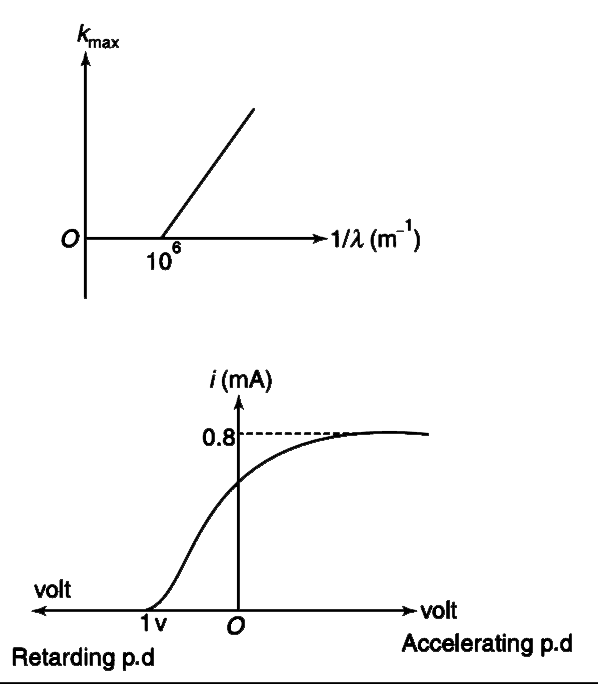1.5 mW of 400 nm light is directed at a photoelectric cell. If 0.1% of the incident photons produce photoelectrons, find the current in the cell.
0.32μA
0.58μA
0.84μA
0.48μA
The correct Answer is:D
Step by step video, text & image solution for 1.5 mW of 400 nm light is directed at a photoelectric cell. If 0.1% of the incident photons produce photoelectrons, find the current in the cell. by Physics experts to help you in doubts & scoring excellent marks in Class 12 exams.
Updated on:21/07/2023Topper's Solved these Questions
- DUAL NATURE OF RADIATION AND MATTERBOOK - NARAYNACHAPTER - DUAL NATURE OF RADIATION AND MATTEREXERCISE - EVALUTATE YOURSELF - 3
5 Videos
- DUAL NATURE OF RADIATION AND MATTERBOOK - NARAYNACHAPTER - DUAL NATURE OF RADIATION AND MATTEREXERCISE - EVALUTATE YOURSELF - 4
5 Videos
- DUAL NATURE OF RADIATION AND MATTERBOOK - NARAYNACHAPTER - DUAL NATURE OF RADIATION AND MATTEREXERCISE - EVALUTATE YOURSELF - 1
2 Videos
- CURRENT ELECTRICITYBOOK - NARAYNACHAPTER - CURRENT ELECTRICITYEXERCISE - Level 6
43 Videos
- DUAL NATUREBOOK - NARAYNACHAPTER - DUAL NATUREEXERCISE - LEVEL-II (H.W)
17 Videos
Similar Questions
In photoelectric experiment set up, the maximum kinetic energy (kmax) of emitted photoelectrons was measured for different wavelength (λ) of light used. The graph of kmax vs 1λ was obtained as shown in first figure. In the same setup, keeping the wavelength of incident light fixed at l, the applied potential difference was varied and the photoelectric current was recorded. The result has been shown in graph in second figure.
(a) Find λ is Å
(b) Taking the photo efficiency to be 2% (i.e. percentage of incident photons which produce photoelectrons) find the power of light incident on the emitter plate in the experiment. [Take hc=12400eVÅ]

View SolutionUltraviolet light of wavelength 350 nm and intensity 1W/m2 is directed at a potassium surface having work function 2.2 eV
(ii) if 0.5 percent of the incident photons produce photoelectric effect, how many photoelectrons per second are emitted from the potassium surface that has an area 1cm2.
Ekmax=1.3eV,n=8.8×1011photo electronsecondorr=Nhvt=nhv
View Solution
Knowledge Check
A 100 W point source emits monochromatic light of wavelength 6000A
Q. 1.5 mW of 4000A light is directed at a photoelectric cell If 0.10 per cent of the incident photons produce photoelectrons, find current is the cell. [Given h=6.6×10−34Js,c=3×108ms−1 and e=1.6×10−19C]A0.59μAB1.16μAC0.48μAD0.79μAA beam of light of wavelength 400nm and power 1.55 mW is directed at the cathode of a photoelectric cell. If only 10% of the incident photons effectively produce photoelectrons, then find current due to these electrons. (given hc=1240eV−nm,e=1.6×10−19C)
A5μAB40μAC50μAD114μAUltraviolet light of wavelength 66.26 nm and intensity 2W/m2 falls on potassium surface by which photoelectrons are ejected out. If only 0.1% of the incident photons produce photoelectrons, and surface area of metal surface is 4m2, how many electrons are emitted per second?
A2.67×1015B3×1015C3.33×107D4.17×1016
How will photoelectric current through a photoelectric cell change on increasing the intensity of the light incident on the cell ?
View SolutionUltraviolet light of wavelength 300nn and intensity 1.0Wm−2 falls on the surface of a photosensitive material. If one per cent of the incident photons produce photoelectrons, then the number of photoelectrons emitted per second from an area of 1.0 cm2 of the surface is nearly
View Solution10−3 W of 5000A light is directed on a photoelectric cell. If the current in the cell is 0.16μA, the percentage of incident photons which produce photoelectrons, is
View Solution10−3 W of 5000Å light is directed on a photoelectric cell. If the current in the cell is 0.16 mA, the percentage of incident photons which produce photoelectrons, is
View SolutionA : On increasing the intensity of light , the number of photoelectrons emitted is more . Also the kinetic energy of each photo increases but the photoelectric current is constant
R : Photoelectric current is independent of intensity but increases with increasing frequency incident radiation
View Solution
